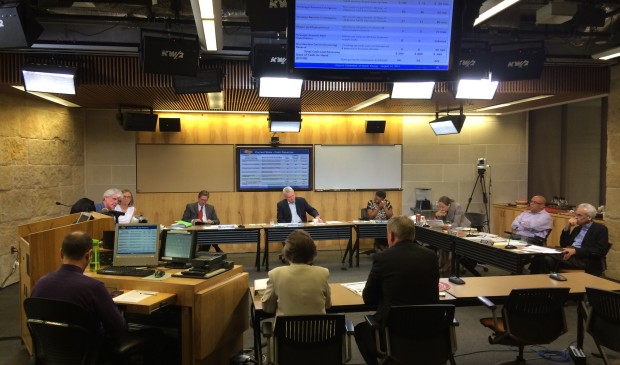Austin Energy to cut planned 2015 fee increase
Monday, August 18, 2014 by
Tyler Whitson Austin City Council members are studying an Austin Energy plan to lower regulatory fees in 2015, which will cut the average monthly residential bill. Utility officials floated the plan Thursday at the Council Committee on Austin Energy.
Austin Energy officials say the proposal would reduce a consumer’s portion of an Electric Reliability Council of Texas regulatory fee. The change would lower a planned increase in the average residential bill to $2.72 from $4.57. Austin Energy estimates that the average FY2015 residential monthly bill will be $107.90. the proposal would cut costs by reducing a fuel charge to $2.72 from $4.57 as well as a consumer’s portion of an Electric Reliability Council of Texas fee. Under the plan, the increase in the average monthly residential bill would drop to about 36 cents from a proposed $2.23 on an average bill of about $110.
Officials say the move would result in a $19 million revenue loss next year for the city-owned electric utility, but that they will make up the difference over the next two years as regulatory costs are lower.
Rate watchdog groups had complained that Austin Energy’s original 3.4 percent proposed increase was over a 2 percent cap on rate increases previously agreed to by the utility. Pressure from groups such as the Coalition for Clean Affordable Reliable Energy and others likely influenced the utility to propose the cut.
Mayor Lee Leffingwell criticized Austin Energy’s proposed budget during a July 31 Council Budget Work Session, citing the affordability goal that included the 2 percent cap Council set during a previous budget cycle. (See Austin Monitor, Aug. 1.) The new affordability results would meet the goal’s criteria, falling in at 1.9 percent.
Austin Energy Chief Financial Officer Ann Little explained Thursday that the new proposal takes into account “disappointing” data resulting from cool temperatures in May, June and July. “Usually, our summer months bring in more kilowatt hours,” she said. “But because of the weather, that didn’t happen.”
Little added that increased energy usage would likely have allowed the utility to reduce the next fiscal year’s power supply adjustment, a measure that recovers fuel and primarily purchased power costs.
The new proposed power supply adjustment increase is actually slightly higher than previously projected, moving from an average monthly bill increase for residential customers of $2.34, or 6.3 percent, to $2.36, or 6.36 percent. “It’s about $500,000 higher, which is very minimal when you’re talking about a $450 million item,” Little said.
The calculations led Austin Energy officials to look elsewhere for potential cost reductions. They noted that transmission costs — which make up a substantial portion of regulatory fees — are increasing by $25 million in the next fiscal year and will account for about 8 percent of the utility’s expenditures.
Little explained that the primary driver of this increase is the Public Utility Commission of Texas’ current Competitive Renewable Energy Zones project. It is designed to significantly increase the state’s renewable energy resources, primarily through wind generation infrastructure.
A large portion of the project’s costs comes from constructing transmission lines that will connect renewable energy sources in remote parts of Texas to larger cities, including Austin. “The lines are almost complete,” she said. “We know that they’ll continue to build transmission, but not at that rate, so we think that in future years that increase will be much less.”
Council Member Bill Spelman sought clarification on these predictions, asking if there is an expectation that the utility will be able to make up the difference the following year. “It may take more than one year to make up the difference,” Little said. “It depends on how accurate our forecast is.”
Spelman also questioned how the power supply adjustment would fit into this prediction. “If the power supply adjustment is as large or larger next year as it is this year, you won’t have much wiggle room to increase the regulatory charge because you’re going to hit your 2 percent too quickly,” he said.
“That is correct, and that is our concern,” Little responded.
Austin Energy General Manager Larry Weis addressed another question from Spelman about the predictability of the power supply adjustment. “We do the very best we can to forecast,” he said. “We really won’t know until about this time next year how we’ve performed.”
Weis pointed out that having funds in a Strategic Reserve Rate Stabilization Fund would help make the power supply adjustment more predictable in the future. “We believe that prudent business would be to have some money in there to address just what we’re talking about,” Weis said. He referred to it as a “shock absorber” that would help keep the utility from going over its affordability cap.
(Due to an editing error, this story was updated Aug. 18 with corrected information to reflect that a proposed reduction in Austin Energy’s average FY2015 residential bill would come from reducing a regulatory fee, not by reducing a fuel charge.)
You're a community leader
And we’re honored you look to us for serious, in-depth news. You know a strong community needs local and dedicated watchdog reporting. We’re here for you and that won’t change. Now will you take the powerful next step and support our nonprofit news organization?









